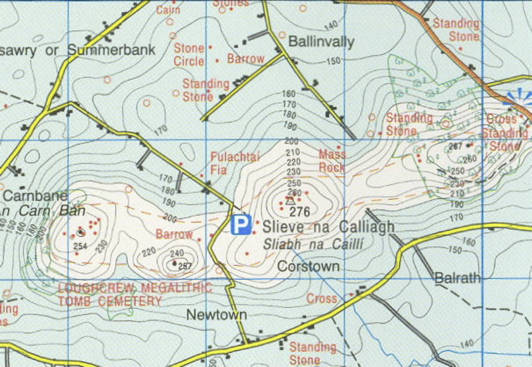Westmeath Way
Closure Notice - October 2024. Please note, the Westmeath Way is temporarily closed while work is completed on the trail
County Westmeath, one of Ireland's smaller counties, is in the midlands, and the Hill of Uisneach in the county is considered the geographical centre of the country. The Westmeath Way is a 33km-long low-level linear walking route from the town of Kilbeggan, famous for its whiskey distilling and horse racing, to the town of Mullingar, the administrative centre of the county. The route follows a section of the River Brosna and then public roads northwards to the townsland of Lilliput on the shores of Lough Ennell: Jonathan Swift is said to have stayed with friends on the lake's shore, and used the name for his fantasy island in Gulliver's Travels. The route then continues by road, fields and woodland path to reach the north end of the lake, and from there it goes by road and canal tow path into Mullingar. Apart from pleasant river-bank stretches (which may be a little wet and overgrown), woodland sections and canal bank, much of this route is on road, some sections of which carry fast traffic.
Trail Management
Westmeath County Council, County Buildings, Mullingar, Co Westmeath, Tel: 044 9332000, www.westmeathcoco.ie
Facilities
Car parking At Start - on street in Kilbeggan At End - on streets or in car parks in Mullingar (probable charge)
WALKERS SHOULD NOTE THAT AT PRESENT THERE IS NO ACCESS OVER THE PRIVATELY OWNED LAND FROM LADESTOWN TO KEOLTOWN WOOD SO THE WAY IS CLOSED BETWEEN LADESTOWN AND DYSART. WALKERS ARE ADVISED TO PLEASE REFRAIN FROM WALKING THIS SECTION UNTIL FURTHER NOTICE. 14 kms or 41% of the Way follows local roads. ***Under no circumstances should dogs be taken on farmland sections of the Westmeath Way***

Map Guides
WestmeathWay Sli na h-Iarmhi Waymarked Walking Route - published by EastWest Mapping for Westmeath Tourism

Jem Smyth from Dublin
We recently had the unfortunate experience of attempting to traverse "The Westmeath Way," and We must say that it was an unmitigated disaster from start to finish. This supposedly scenic trail proved to be a complete letdown, riddled with problems that range from poor trail management to an outright lack of basic amenities and safety measures. Allow us to walk you through the litany of disappointments that awaited us along this ill-conceived route.
Setting out from Kilbeggan, the initial stretch of the track was overgrown to the point of absurdity, particularly along the river. The trail creators seemed to have forgotten the concept of maintenance, as the path forced us to navigate through an unruly tangle of vegetation, all the while dodging cow manure that was strewn across the route. This lack of upkeep would have been disheartening enough, but things quickly escalated as We reached a style that was submerged due to flooding, only to find myself crossing what can only be described as a cow toilet. The stench and unsanitary conditions were nothing short of repulsive.
The trail then led us through a farm section, where a congregation of curious cows observed my progress. While it was advised to walk quickly to avoid any unpleasant interactions, the sheer fact that such a warning had to be given is a testament to the poor design of the trail. As if this wasn't bad enough, We then encountered a grueling 7-kilometer stretch of overgrown river walking. This was not only uncomfortable but an exercise in frustration, as the lack of proper waymarking left us feeling lost and unsure of my direction.
The real nadir of this experience, however, came when We reached a style entering a field teeming with animals: over 30 cows, a bull, and a goat. The lack of clear guidance on how to safely navigate this section of the trail was alarming, to say the least. The cows proved to be more than a mere nuisance; their aggressive behavior and harassment reached such levels that even the presence of an electric fence couldn't deter them. A gap in the fence near a hill made matters worse, creating a potentially dangerous situation.
Despite the struggle to maneuver through this tumultuous landscape, the ordeal was far from over. The cows' behavior further intensified as they obstructed the path around the hill, hampered by the high bushes that choked the surroundings. It was nearly impossible to ascertain if they were intentionally trapping the exit, adding an extra layer of danger to an already fraught situation. Frustration reached its peak, and in an attempt to escape this chaotic scene, We had no choice but to turn back.
Adding insult to injury, the canal path, which should have provided an alternative route, was inaccessible, further highlighting the dismal waymarking and lack of trail maintenance. Frustrated and disheartened, We was forced to take a "longcut" through a field, a decision driven by desperation and a desire to escape this nightmare. Little did We know, my ordeal had consumed an entire day, spanning from 10 am to 6:30 pm, on what can only be described as a wasted effort.
In summary, "The Westmeath Way" is a cautionary tale in trail management gone awry. From overgrown paths and unsanitary conditions to a lack of proper waymarking and safety measures, this trail is a prime example of how not to create a walking experience. While the concept of exploring the countryside on foot is commendable, the execution in this case was nothing short of disastrous. It's high time for a comprehensive overhaul of the trail, considering the following solutions to transform it into a more enjoyable and safe experience:
1. **Regular Maintenance:** Implement a regular maintenance schedule to clear overgrown sections, ensuring the path remains navigable and safe.
2. **Clear Waymarking:** Invest in comprehensive and clear waymarking to guide walkers seamlessly along the trail, reducing the chances of getting lost.
3. **Safety Signage:** Install clear and informative signage, detailing how to safely navigate areas with livestock, minimizing the risk of encounters turning hostile.
4. **Alternative Routes:** Develop alternative routes in case of inaccessible sections, allowing walkers to continue without hindrance.
5. **Interactive Maps:** Provide digital maps or apps that offer real-time navigation assistance, ensuring walkers stay on the right path.
6. **Animal Management:** Collaborate with local farmers to manage livestock and create designated paths to ensure safe coexistence.
7. **Emergency Points:** Establish designated points equipped with emergency contact information, offering a lifeline for walkers in distress.
8. **Regular Inspections:** Conduct routine inspections to identify and rectify potential hazards, guaranteeing a safer trail experience.
9. **Feedback Mechanism:** Create a system for walkers to provide real-time feedback, enabling continuous improvement and quick response to issues.
In conclusion, "The Westmeath Way" has a long way to go before it can be considered a worthwhile walking trail. The litany of problems, from overgrown paths to unsafe encounters with livestock, has tarnished its potential as an enjoyable outdoor experience. However, with a concerted effort towards better trail management and the implementation of the suggested solutions, there is hope for this trail to evolve into a safer, more enjoyable, and fulfilling adventure for all who wish to explore it.
Attention, fellow adventurers! Before embarking on 'The Westmeath Way' walk, please take heed of the myriad challenges and issues that await you. This trail, unfortunately, falls far short of providing a pleasant or safe experience. From overgrown paths that make navigation a nightmare to encounters with aggressive livestock, this walk is marred by a lack of proper maintenance, safety measures, and clear waymarking. The risk of wasting your time, getting lost, or encountering unsanitary conditions is incredibly high. Please DO NOT WASTE YOUR TIME (Unless they are willing to upgrade this Walk!).